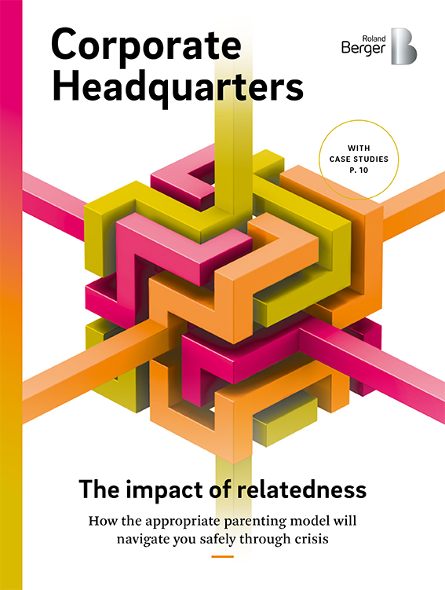

Corporate headquarters: How the appropriate parenting model will navigate you sa
By Fabian Huhle and Andreas Stocker
The more similar the business segments are, the greater the value the headquarters can add
"A corporate headquarters that exerts strong control must take on more tasks – and be better qualified."
In times of crisis, the focus regularly turns to the corporate headquarters (CHQ). Is it too big? Too expensive? Does it deliver the required performance? Does it recruit and develop the right talents?
And it's no different now, in the middle of the COVID-19 pandemic, which is proving an enormous challenge to businesses across industry sectors. In a phase like this, it all comes down to leadership – the decentralized business units need a clear strategy for business model and portfolio realignment.
So which parenting model is the best choice to meet these needs? One thing is for sure: There is no such thing as the "perfect" corporate headquarters. But the authors of the latest edition of the Corporate Headquarters study offer some initial pointers for how companies can approach an optimum parenting model. Their aim is to help create the basis for a robust and sustainable parenting model.

"A control centre that over- or under-controls is not only inefficient. Above all, it is expensive."
Step 1: Evaluate the business portfolio
The search for the appropriate parenting model always starts by looking at the operational business. If the different divisions are very similar in nature, the corporate headquarters can create group-wide synergies by providing central services, expertise and resources and by efficiently supporting similar processes within a harmonized structure. If the business portfolio is diverse, corporate headquarters should focus instead on selected activities such as portfolio management and group-wide governance.
The study authors know from experience that if a company fails to take this into account, misallocation of financial and human resources is very likely because the corporate headquarters is providing services that are simply not being used by the business units. For example, it will prove very difficult for a strong central procurement organization to realize economies of scale in a company with highly diverse business segments because the materials being purchased are too different.
Step 2: Select the parenting model
Two main things will determine your choice of the right parenting model. The first, as already mentioned, is the relatedness of your business units. This is the dominant factor in the short term, given that repositioning business divisions is normally a costly and time-consuming affair. The second key parameter is the level of control to which your headquarters aspires. The greater the control, the closer the CHQ will be to the day-to-day business and the more operational influence it will exert. Depending on the similarities between the business units and the degree of control enjoyed by the holding company, there are four different parenting models to choose from for a corporate headquarters: investor, architect, strategist and integrator.
Whereas an investor, such as an investment fund, manages its portfolio simply by buying and selling portfolio companies, for the other three models the scope of tasks and the extent of intervention rises continually as you move from architect to strategist to integrator. It's only when the CHQ adopts the most suitable role and acts accordingly that the optimum balance between costs and benefits, added value and acceptance can potentially be attained.
Step 3: Align the business to the new model
In the final step the corporate headquarters' activities must be adapted to match the (new) structure. This involves assessing the skills relevant to the company and defining the specific level of CHQ performance. It is crucial to be nuanced about the performance level you're aiming at. While all parenting models require things like structured reporting & performance management, the depth of reporting will vary.
Then you need to reduce the amount of double work and the level of efficiency losses by locating individual functions at the holding, segment or service level. In addition, an efficiency program should be carried out in overhead functions to eliminate any redundancies that may exist.
Finally, the focus turns to the value-adding activities that provide orientation and help navigate the company through crisis. These include activities that create identity and shape the corporate culture, such as communications, leadership development or talent management.
Register now to download the white paper to learn more about the three steps to finding the right parenting model and get regular insights into the topic of Restructuring & Performance improvement.




